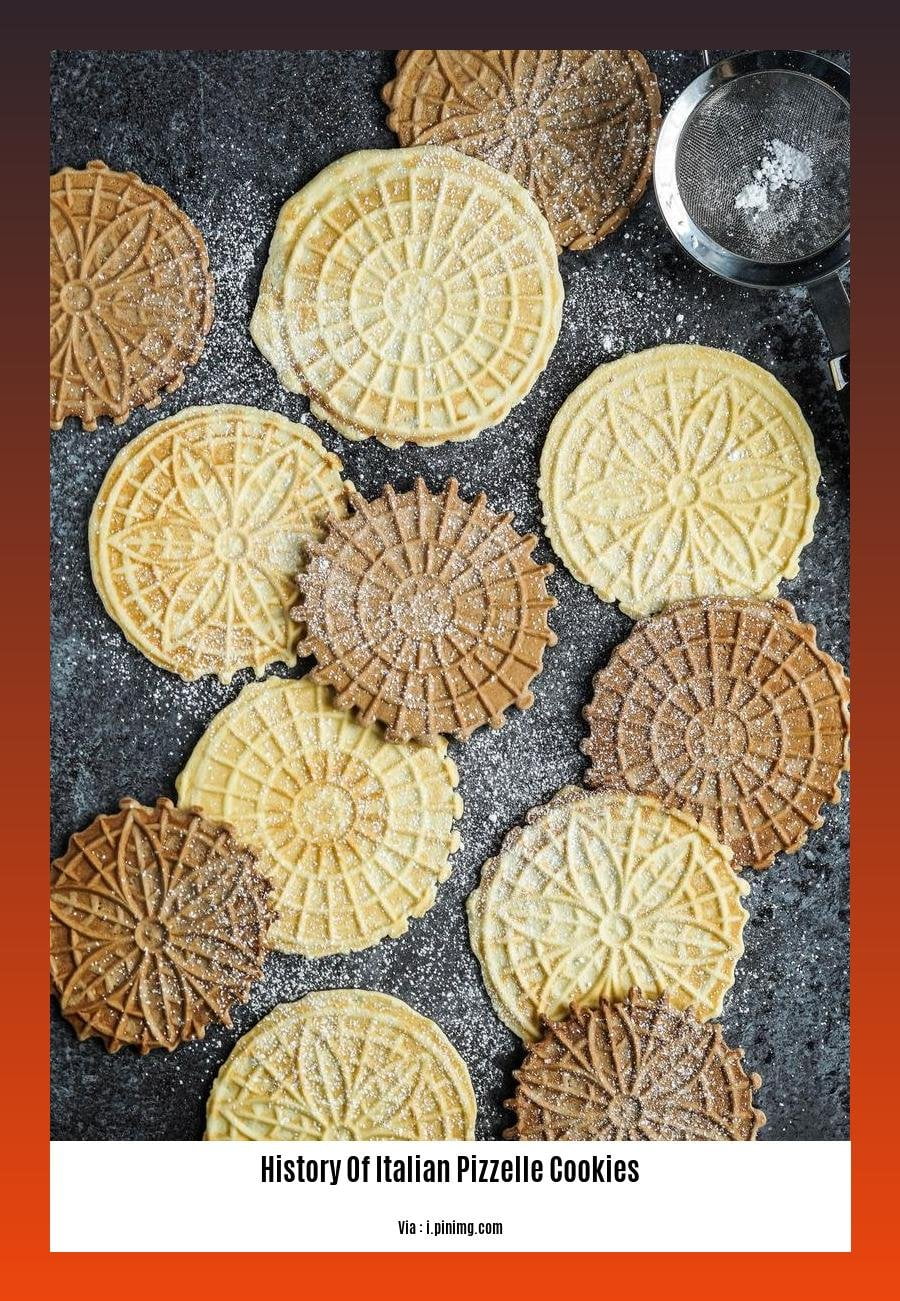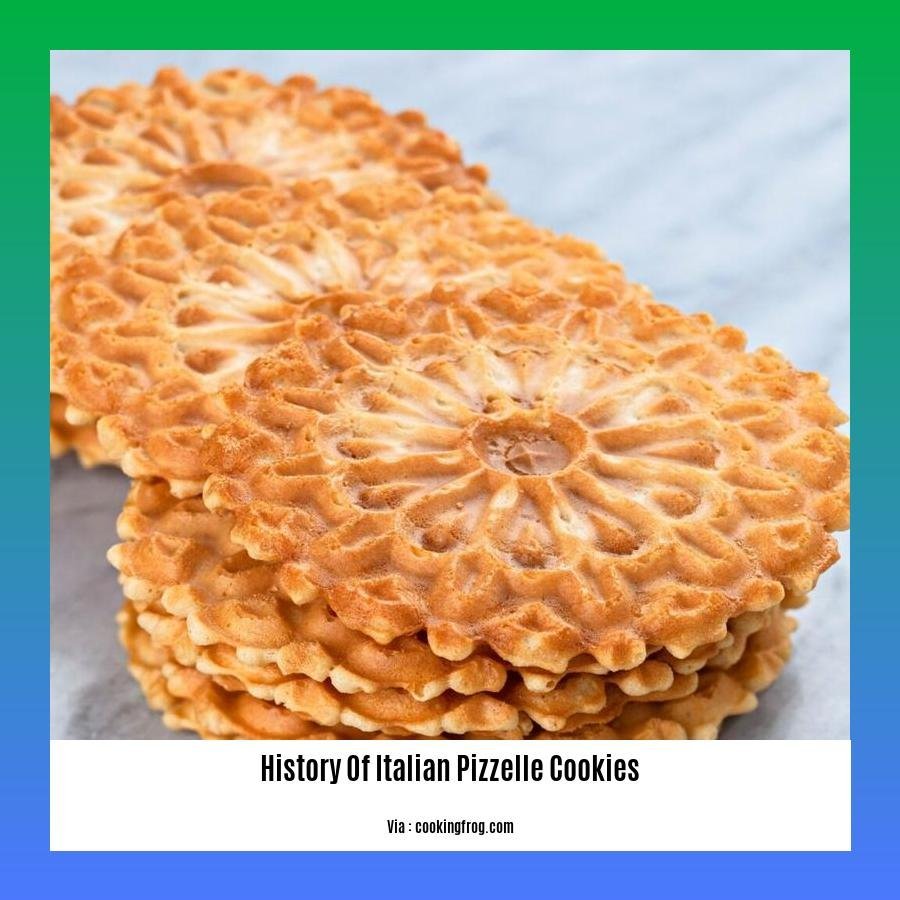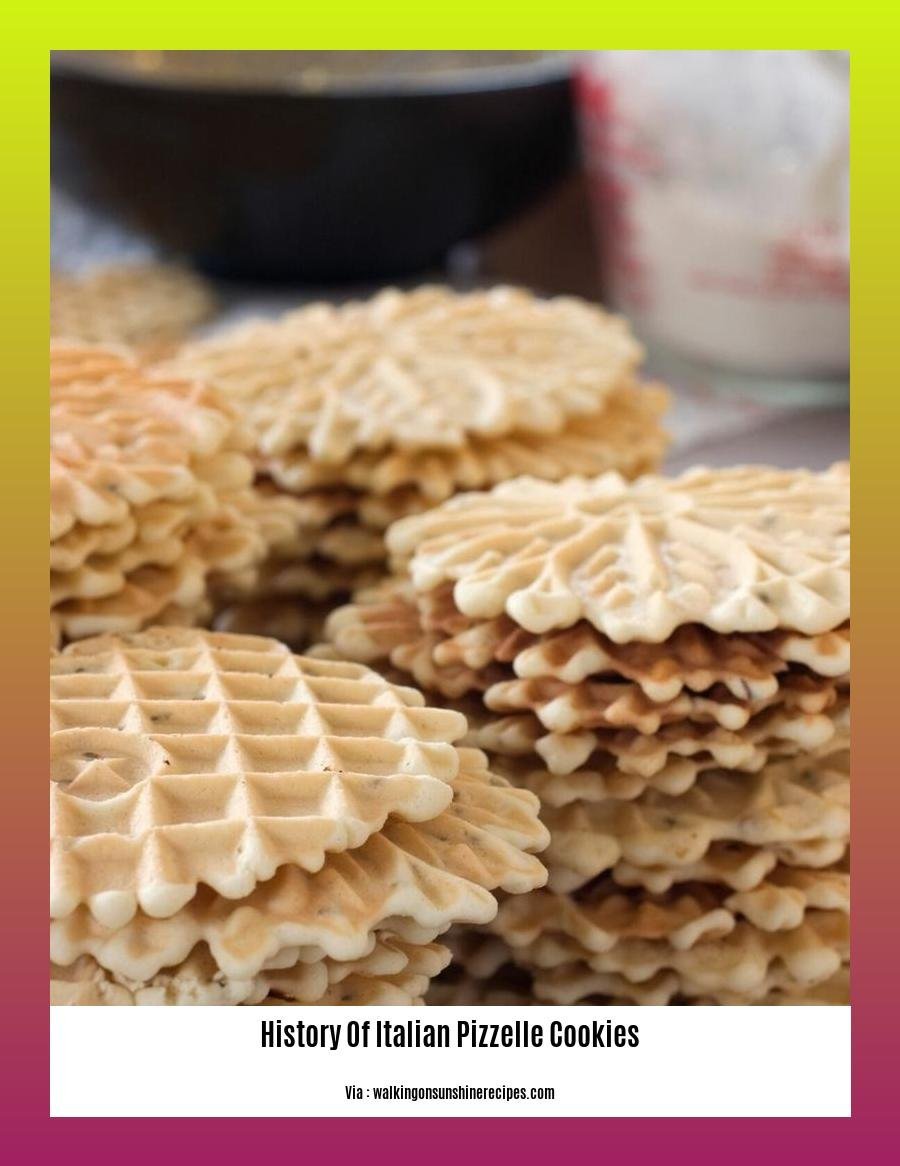Embark on a delectable journey through time with us as we explore the captivating history of Italian Pizzelle Cookies. These cherished treats have graced dinner tables and dessert platters for centuries, carrying with them tales of tradition, cultural heritage, and culinary artistry. Join us as we delve into the origins of these beloved cookies, tracing their evolution from humble beginnings to their present-day status as a symbol of Italian baking excellence.
Key Takeaways:
- Pizzelle cookies are the world’s oldest known cookies, dating back to the 8th century.
- They are made using iron plates to flatten the batter.
- The name “pizzelle” comes from the Italian word for “round and flat.”
- Originating in the Abruzzo region of Italy, they were initially made for the “Festival of the Snakes.”
- Similar pizzelle-style cookies are found in various cultures worldwide.
History Of Italian Pizzelle Cookies

Prepare to embark on a delectable journey through the annals of Italian culinary history as we delve into the fascinating origins of pizzelle cookies, a timeless treat that has captivated taste buds for centuries.
The Genesis of Pizzelle
Unveiling the History Of Italian Pizzelle Cookies, our exploration begins in the heart of Italy, where these beloved cookies first emerged during the 8th century. Crafted by skillful artisans in the Abruzzo region, pizzelle were born as part of the revered “Festival of the Snakes.” Their distinctive name, derived from the Italian word “pizze,” aptly describes their round and flat shape.
A Culinary Legacy
Pizzelle cookies soon transcended regional boundaries, captivating palates across Italy. Their unique flavor profile and intricate designs made them a staple at celebrations and gatherings. Over time, these delectable treats found their way into the culinary traditions of various cultures, showcasing their enduring appeal.
The Art of Pizzelle Making
The creation of pizzelle is an art form in itself. A traditional batter, meticulously crafted from flour, sugar, eggs, and flavorings, is delicately flattened between two hot iron plates adorned with intricate designs. As the batter sizzles and transforms, tantalizing aromas fill the air, promising a symphony of flavors.
A Timeless Tradition
Today, History Of Italian Pizzelle Cookies continues to captivate bakers and dessert enthusiasts alike. These time-honored treats have stood the test of time, evolving with contemporary twists while preserving their authentic charm. From classic anise-infused pizzelle to innovative variations featuring chocolate, nuts, and fruit, the versatility of these cookies knows no bounds.
Conclusion
Our exploration of the History Of Italian Pizzelle Cookies unveils a delectable tapestry woven with tradition, craftsmanship, and enduring appeal. These timeless treats continue to grace tables and warm hearts, embodying the rich heritage of Italian culinary artistry.
Have you ever been curious about the history of pizzelle? If so, you won’t want to miss your chance to read about the History of Pizzelles in detail, so check it out!
Looking for a way to make your favorite pizzelle cookies from scratch? Then, you’ll want to learn more about Pizzelle Cookies History to know the origin of it.
Pizzelle as a Symbol of Italian Heritage: Rituals, traditions, and family gatherings
Pizzelle are crispy waffle cookies with a centuries-old history deeply intertwined with Italian culture. These delicate treats are ubiquitous at celebrations, symbolizing the cherished traditions and family bonds that shape Italian heritage.
In the heart of Abruzzo, Italy, pizzelle emerged in the 8th century as part of the “Festival of the Snakes.” These cookies have been lovingly crafted ever since, with their intricate designs pressed into hot iron molds.
At the core of pizzelle’s significance lies their role in Italian gatherings. These cookies grace the tables at weddings, christenings, and religious festivals, serving as a symbol of joy and celebration. Each bite evokes memories of shared laughter, heartfelt conversations, and the warmth of family.
The preparation of pizzelle is an art form passed down through generations. Families gather to make these treats together, transforming the kitchen into a hub of activity and storytelling. The sweet aroma of pizzelle baking fills the air, creating a sensory experience that transports one to the heart of Italian culinary traditions.
Key Takeaways:
- Pizzelle originated in Italy’s Abruzzo region during the 8th century.
- They symbolize joy, celebration, and the warmth of family gatherings.
- Pizzelle are traditionally made with a batter pressed between hot iron molds.
- The art of preparing pizzelle is a cherished tradition passed down through generations.
- These cookies continue to captivate bakers and dessert enthusiasts today, symbolizing Italian culinary heritage.
Sources:
- Traditional Italian Pizzelle Recipe
- The BEST Pizzelle Recipe
Modern Interpretations of Pizzelle: Creative Adaptations and Fusion Flavors

Pizzelle, the beloved Italian waffle cookies, have captivated palates for centuries. While traditional recipes remain cherished, modern interpretations are breathing new life into this classic treat. From innovative flavor combinations to fusion influences, these creative adaptations showcase the versatility and adaptability of pizzelle.
Flavorful Adventures:
- Chocolate-Drizzled Delights: Rich chocolate ganache transforms pizzelle into a decadent dessert, perfect for satisfying sweet cravings.
- Citrusy Zest: Infusing batter with lemon or orange zest adds a refreshing tang, creating a vibrant twist on the classic.
- Spiced Sensations: Spices like cinnamon, nutmeg, or ginger warm up pizzelle, offering a cozy and aromatic experience.
Cultural Fusions:
- East Meets West: Pizzelle batter mixed with matcha powder creates a harmonious blend of Italian and Japanese flavors.
- Middle Eastern Magic: Rose water and saffron add a touch of exoticism, evoking the vibrant flavors of the Middle East.
- South American Spice: Churro-inspired pizzelle, dusted with cinnamon sugar, combine the crispy texture of pizzelle with the beloved sweetness of churros.
Fusion Flavors Table:
| Traditional Flavor | Modern Interpretation |
|---|---|
| Anise | Chocolate-drizzled |
| Vanilla | Citrusy zest |
| Lemon zest | Spiced with ginger |
Key Takeaways:
- Modern pizzelle interpretations offer endless possibilities for flavor exploration and fusion.
- Creative adaptations preserve the essence of tradition while introducing exciting new dimensions.
- Fusion flavors blend culinary traditions, creating innovative and globally inspired treats.
Relevant Sources:
- Modern Pizzelle Flavors: A Sweet Departure from Tradition
- International Twist on Pizzelle: A Culinary Journey
Pizzelle in Contemporary Italian Cuisine: Culinary artistry and desserts
Pizzelle, the delicate and crispy Italian waffle cookies, have captivated dessert enthusiasts for centuries. In contemporary Italian cuisine, they have evolved into culinary masterpieces, showcasing the artistry and creativity of Italian pastry chefs.
Key Takeaways:
- Pizzelle originated in the Abruzzo region of Italy, dating back to at least the 8th century.
- Traditionally made with a simple dough of flour, sugar, eggs, and anise, contemporary pizzelle incorporate innovative flavors and ingredients.
- The distinctive round and flat shape of pizzelle is achieved by pressing the dough between intricately designed hot iron plates.
- Pizzelle are not just a sweet treat but also serve as a canvas for culinary creativity, adorned with intricate patterns, glazes, and fillings.
- From classic anise-flavored pizzelle to modern interpretations with chocolate, pistachio, and even savory fillings, the versatility of pizzelle is boundless.
Culinary Artistry
Contemporary Italian chefs are elevating pizzelle in innovative ways, experimenting with different dough compositions, flavor combinations, and presentation techniques. From delicate lace-like pizzelle to vibrant and colorful creations, these cookies are a feast for the eyes and taste buds. Chefs utilize a variety of glazes, such as chocolate, vanilla, or pistachio, to enhance their flavors and create visually stunning desserts.
Desserts
Pizzelle’s versatility extends beyond their traditional role as a cookie. They are now incorporated into a wide range of desserts, adding a touch of crispy sweetness and Italian charm. Chefs use pizzelle to create elaborate cannoli shells, ice cream sandwiches, and even elegant layered cakes. The delicate texture of pizzelle complements the richness of fillings and frostings, creating a harmonious dessert experience.
Cultural Heritage
While pizzelle have evolved over time, they remain deeply rooted in Italian culinary heritage. They are still a beloved treat served during celebrations, holidays, and family gatherings. The pizzelle iron, with its intricate designs, has become a symbol of Italian craftsmanship and tradition. Each pizzelle bears the imprint of its unique iron, making it a cherished keepsake that connects generations.
Citations:
- https://www.tastingtable.com/1118428
FAQ
Q1: What is the history of Italian pizzelle cookies?
A1: Pizzelle cookies originated in the Abruzzo region of central Italy in the eighth century, initially crafted for the “Feast of the Serpents.” Over time, the recipe evolved to include eggs, sugar, and additional flavorings, becoming popular as a Christmas and Easter treat.
Q2: What are the key ingredients in pizzelle cookies?
A2: Traditional pizzelle dough consists of flour, sugar, eggs, butter or vegetable oil, and flavorings like anise or vanilla. The batter is pressed between hot iron plates to create the distinct pizzelle shape.
Q3: What factors impact the texture of pizzelle cookies?
A3: The texture of pizzelle cookies depends on the ingredients and preparation method. Using cold batter and cooking for a shorter duration results in crispy pizzelle, while a warmer batter and longer cooking time produce a softer, chewier texture.
Q4: What is the cultural significance of pizzelle cookies in Italy?
A4: Pizzelle cookies hold deep cultural significance in Italy, associated with celebrations and religious festivals. The name “piazza,” meaning “square,” reflects their traditional flat and round shape, often decorated with intricate designs.
Q5: How have pizzelle cookies evolved over time?
A5: Modern variations of pizzelle cookies have emerged, incorporating different flavors such as chocolate, peanut butter, or cinnamon sugar. Additionally, innovative interpretations include using pizzelle as a base for desserts like can
- Mastering Leader in Spanish: The Complete Guide - April 19, 2025
- Uncovering Surprising Parallels: England Size Compared to US States - April 19, 2025
- Old Mexico Map: Border Shifts 1821-1857 - April 19, 2025
















